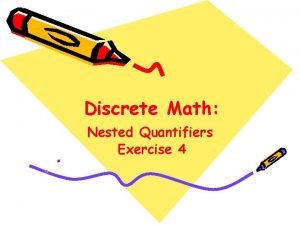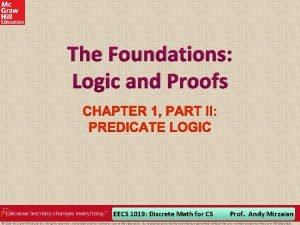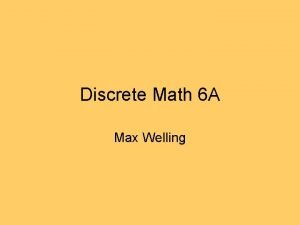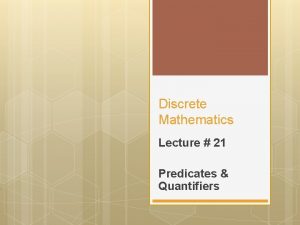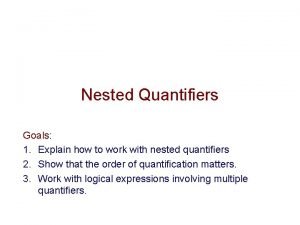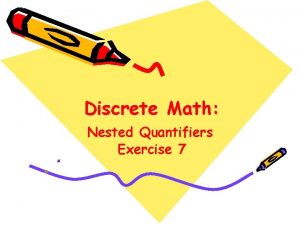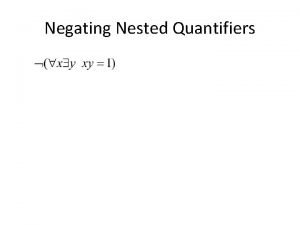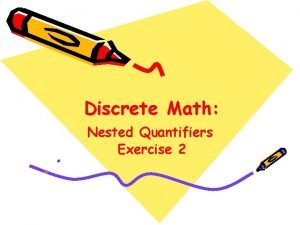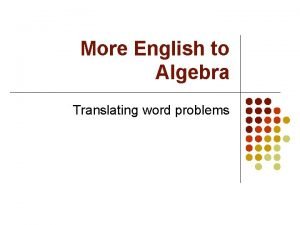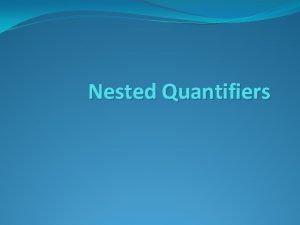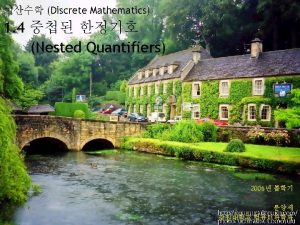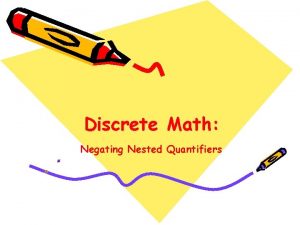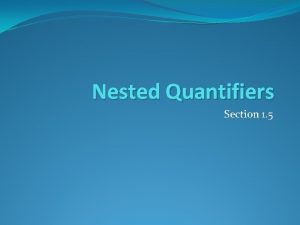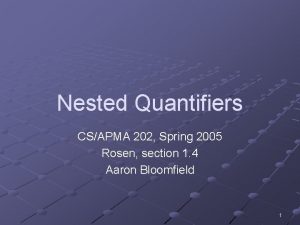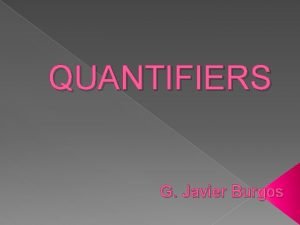Nested Quantifiers Section 1 5 Translating Nested Quantifiers









- Slides: 9

Nested Quantifiers Section 1. 5

Translating Nested Quantifiers into English Example 1: Translate the statement x (C(x )∨ y (C(y ) ∧ F(x, y))) where C(x) is “x has a computer, ” and F(x, y) is “x and y are friends, ” and the domain for both x and y consists of all students in your school. Solution: Every student in your school has a computer or has a friend who has a computer. Example 2: Translate the statement x y z ((F(x, y)∧ F(x, z) ∧ (y ≠z))→¬F(y, z)) Solution: There is a student none of whose friends are also friends with each other.

Translating Mathematical Statements into Predicate Logic Example : Translate “The sum of two positive integers is always positive” into a logical expression. Solution: 1. Rewrite the statement to make the implied quantifiers and domains explicit: “For every two integers, if these integers are both positive, then the sum of these integers is positive. ” 2. Introduce the variables x and y, and specify the domain, to obtain: “For all positive integers x and y, x + y is positive. ” 3. The result is: x y ((x > 0)∧ (y > 0)→ (x + y > 0)) where the domain of both variables consists of all integers

Translating English into Logical Expressions Example: Use quantifiers to express the statement “There is a woman who has taken a flight on every airline in the world. ” Solution: 1. Let P(w, f ) be “w has taken f ” and Q(f, a) be “f is a flight on a. ” 2. The domain of w is all women, the domain of f is all flights, and the domain of a is all airlines. 3. Then the statement can be expressed as: w a f (P(w, f ) ∧ Q(f, a))

Negating Nested Quantifiers Example 1: Recall the logical expression developed in the last slide: w a f (P(w, f ) ∧ Q(f, a)) Part 1: Use quantifiers to express the statement that “There does not exist a woman who has taken a flight on every airline in the world. ” Solution: ¬ w a f (P(w, f ) ∧ Q(f, a)) Part 2: Now use De Morgan’s Laws to move the negation as far inwards as possible. Solution: 1. ¬ w a f (P(w, f ) ∧ Q(f, a)) 2. w ¬ a f (P(w, f ) ∧ Q(f, a)) by De Morgan’s for 3. w a ¬ f (P(w, f ) ∧ Q(f, a)) by De Morgan’s for 4. w a f ¬ (P(w, f ) ∧ Q(f, a)) by De Morgan’s for 5. w a f (¬ P(w, f ) ∨ ¬ Q(f, a)) by De Morgan’s for ∧. Part 3: Can you translate the result back into English? Solution: “For every woman there is an airline such that for all flights, this woman has not taken that flight or that flight is not on this airline”

Questions on Translation from English Choose the obvious predicates and express in predicate logic. Example 1: “Brothers are siblings. ” Solution: x y (B(x, y) → S(x, y)) Example 2: “Siblinghood is symmetric. ” Solution: x y (S(x, y) → S(y, x)) Example 3: “Everybody loves somebody. ” Solution: x y L(x, y) Example 4: “There is someone who loves everyone. ” Solution: x y L(x, y) Example 5: “There is someone who is loved by everyone. ” Solution: y x L(x, y) Example 6: “Everyone loves himself” Solution: x L(x, x)

Can you distribute quantifiers? Example 1: Is the following equivalence valid? x (P(x) ∨ Q(x)) ≡ x P(x) ∨ x Q(x) Solution: Yes, easy to check that LHS is true if and only if RHS is true. Example 2: Is the following equivalence valid? x (P(x) ∧ Q(x)) ≡ x P(x) ∧ x Q(x) Solution: No, Let P(x) stand for x is beautiful and Q(x) stand for x is intelligent. Let the domain be the set of all girls. The LHS says that there exists at least one girl who is both beautiful and intelligent. The RHS says there exists a beautiful girl and there exists an intelligent girl. It is completely possible that RHS is true and yet LHS is false.

Can you distribute quantifiers? Example 1: Is the following equivalence valid? x (P(x) ∧ Q(x)) ≡ x P(x) ∧ x Q(x) Solution: Yes, easy to check that LHS is true if and only if RHS is true. Example 2: Is the following equivalence valid? x (P(x) ∨ Q(x)) ≡ x. P(x) ∨ x Q(x) Solution: No, Let P(x) stand for x is an idiot and Q(x) stand for x is a jerk. Let the domain be the set of all men. The LHS says that each man is either an idiot or a jerk. The RHS says that all men are idiots or all men are jerks. It is completely possible that LHS is true and yet RHS is false.

Exam I Tentative Date: Thursday, the 15 th February. Covering up to Section 1. 6 from the Book. 75 points, 75 minutes. No objective type questions. A crib sheet is allowed. Study Guide with more info will be available later.
